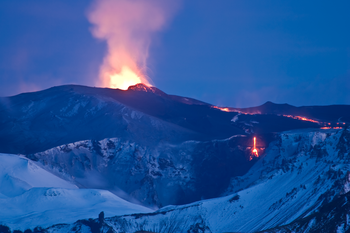Eyjafjallajökull: Difference between revisions
imported>Peter Schmitt (copied text from definition) |
imported>Ro Thorpe mNo edit summary |
||
| (6 intermediate revisions by 2 users not shown) | |||
| Line 1: | Line 1: | ||
{{subpages}} | {{subpages}} | ||
{{Image|Eyjafjallajökull in 2008.png|right|350px|Aerial view of Eyjafjallajökull in August 2008.}} | |||
is a [[volcano]] in the South of [[Iceland]] | '''Eyjafjallajökull''' is a [[volcano]] in the South of [[Iceland]] that became known world-wide when it [[volcanic eruption|erupted]] in March-April 2010. This eruption caused its [[glacier]]s to melt, and the contact between the [[lava]] and the [[water]] produced a giant [[ash cloud]] that reached up into the [[stratosphere]]. The drastically increased concentration of small particles in the air posed a threat to the [[engine]]s of [[air plane]]s, which caused [[aviation authority|authorities]] to block [[air traffic]] in most of [[Europe]] for about one week. On this occasion, the name of the volcano inspired media around the globe to devote some of their content to Iceland and the [[Icelandic language]], both rarely covered otherwise on an international level. | ||
Major previous eruptions of Eyjafjallajökull were recorded in 920, 1612 and 1821-1823, each time followed by eruptions of the neighbouring [[Katla]] volcano, which is also subglacial. | |||
{{Image|Eyjafjallajökull during 2010 eruption.png|right|350px|Eyjafjallajökull during its eruption in April 2010, as seen from neighbouring [[Fimmvörðuháls]].}} | |||
Latest revision as of 08:45, 28 April 2010
Eyjafjallajökull is a volcano in the South of Iceland that became known world-wide when it erupted in March-April 2010. This eruption caused its glaciers to melt, and the contact between the lava and the water produced a giant ash cloud that reached up into the stratosphere. The drastically increased concentration of small particles in the air posed a threat to the engines of air planes, which caused authorities to block air traffic in most of Europe for about one week. On this occasion, the name of the volcano inspired media around the globe to devote some of their content to Iceland and the Icelandic language, both rarely covered otherwise on an international level.
Major previous eruptions of Eyjafjallajökull were recorded in 920, 1612 and 1821-1823, each time followed by eruptions of the neighbouring Katla volcano, which is also subglacial.

Eyjafjallajökull during its eruption in April 2010, as seen from neighbouring Fimmvörðuháls.
